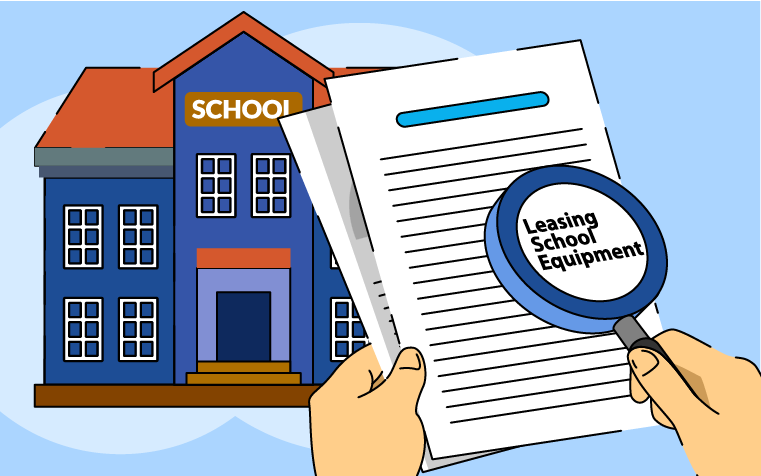Leasing school equipment: what the Government says
We outline the key considerations for leasing school equipment. Our tips are adapted from official Government guidance to help you make an informed choice!

Leasing is an affordable way to provide high-quality equipment for a school. It’s an accessible alternative to purchasing equipment outright, which often involves high upfront costs. However, to get the most out of leasing, it helps to understand some important aspects of the process and the options available!
In this blog, we explain everything you need to know about leasing school equipment, according to the Department of Education’s guidance.
An introduction to leasing
By leasing instead of purchasing, you can provide useful equipment for students whilst continuing to fund other vital areas of your school. The agreement between the school and the leasing company (“lessor”) might work in a similar way to a subscription. This involves fixed periodic rental costs, and can include optional add-on services, such as maintenance.
This way of accessing school equipment works well when it comes to budgeting. For example, the monthly, rather than upfront, costs allow for better cash flow management. However, schools should always do their research to ensure the contracts they enter into won’t result in financial problems. Financial planning is an essential element, and should never be overlooked!
Here is our round-up of key considerations when leasing school equipment:
1. Legitimacy
Before committing to a lease, you should ensure the agreements and lessors are legal and genuine.
Schools should always seek to work with compliant lessors, to ensure they’re entering legal and legitimate contracts. A compliant lessor for schools and academies will only offer operating leases in accordance with the Department for Education’s guidance.
Schools should thoroughly research any potential lessors first to verify their compliance with the relevant rules and regulations. Specifically, they should check that suppliers comply with the standards outlined by:
- The Department for Education (as outlined above)
- The Financial Leasing Association (FLA)
Speaking to colleagues from other schools is another useful way of learning more about a lessor’s track record and reputation. Schools should also read contracts carefully in advance of agreeing to them, to ensure there are no hidden fees or surprises at the end of the rental period.
Utility Rentals is a fully compliant leasing provider for school equipment. All of our rental agreements and subscriptions services run on compliant operating leases. We also pride ourselves in operating with openness and integrity to ensure you receive the equipment you need! You can learn more about our compliant leasing agreements here.
2. Lease types
The Government emphasises the importance of understanding lease types. There are two types: operating leases and financial leases.
State-funded schools or Academies can enter operating lease agreements without prior approval. In an operating lease, schools only pay a proportion of the leased equipment’s value, known as its useful economic life. These agreements usually end before the useful economic life has been reached. In these leases, only the lessor holds the risks and rewards of ownership. Risks could include responsibility for any losses or expenses related to equipment, such as theft, devaluation or repairs. Rewards might involve an increase in the equipment’s value over time.
It’s essential to note that state-funded schools and Academies should only enter operating leases. Financial leases require the Secretary of State’s approval (which is rarely given). These leases often run for a piece of equipment’s entire working life. Unlike operating leases, the leasing company transfers the risks and rewards to the customer (i.e. a school). This is a form of borrowing.
It’s important to note that neither type of lease ends with a school owning the rented equipment.
Utility Rentals only leases equipment with operating leases that comply with the guidance from the Department of Education. Leasing to the education sector is at the heart of our business, and ensuring our products and agreements are compliant with the relevant legislation will always be our top priority!
3. Upgrades
A school’s needs may change during the lease period, which is why upgrades exist. One of the many benefits of leasing equipment is that you have the opportunity to upgrade to new equipment either before or at the end of your rental term.
The ability to upgrade means you won’t be stuck with redundant or outdated equipment. This can prove a more efficient, sustainable solution for schools when compared with purchasing equipment – especially for IT equipment which dates quickly!
If you decide to upgrade before the end of your lease, your lessor may offer you options for doing so. However, any outstanding fees for your existing agreement will need to be settled. Schools have two choices here:
- Pay off outstanding rental fees outright, or
- Add outstanding fees to the new lease, in addition to the new equipment’s cost
The second option incurs capital and interest fees across both agreements, so the former may be preferable.
4. Add-ons
Schools should be aware of the details of maintenance services (if any) for rented equipment. Details to consider include:
- Whether maintenance contracts are included in or are separate to the lease
- If maintenance involves regular visits or requires you to contact your provider
- What charges maintenance incurs and how these are calculated
- The possibility of the maintenance provider closing down in future and how this may affect your lease
Supplies may also be needed for some equipment. To continue using rented equipment, schools should be wary of how they are getting supplies. For example, when renting a printer, the agreement for receiving ink and paper should be considered as well as the lease for the printer itself. When organising supplies, you should:
- Understand whether supply provision involves a separate agreement, and if so, when that ends and how to terminate it
- Ensure you know who provides what supplies
- Be aware of the relative cost of buying supplies separately, on an informal basis
- Understand how the supplier going out of business might affect your equipment use
5. Incentives with leases
Suppliers may offer incentives to entice schools to sign up to their leases. However, schools should be sceptical of these as they can distract from a lease’s costs and terms. Common incentives include:
- Cash back
- ‘Free’ equipment or supplies
- Subsidised rentals
- Offers of using your school to market the lessor’s equipment
These incentives can be framed in a deceptive way. Suppliers might promote them with vested interests, which could lead to hidden costs for your school. As such, schools must be wary! As stated by the Department for Education: “If it sounds too good to be true, it probably is”.
6. End-of-lease arrangements
When your school is leasing equipment, you should be prepared for the end of your lease. Schools should understand the end-of-lease procedure before committing to any agreements.
When a lease ends, schools will usually continue the lease or return their equipment to the leasing company. Regardless of what you decide, it’s important to inform the lessor in advance of the lease ending.
If switching suppliers, ensure that your school clears all its lease debt with your existing lessor. Your new supplier may offer to clear your outstanding lease debt, but you should refuse this. If the new supplier does not pass the settlement on, your school could be liable! Ending a lease yourself will eliminate this risk.
Unlike many of our competitors, Utility Rentals commits to full transparency about our end-of-lease arrangements. We provide a range of flexible options when a lease ends, and we’re happy to discuss these with you upfront before you sign a contract with us.
7. General tips for leasing
For all aspects of the leasing process, apply these useful tips:
- Ensure any verbal or written quotations are consistent with what is in the contract
- Be aware of all of the costs that come with leasing, especially add-on fees
- Use a named and reputable finance company
- Be wary of costs changing throughout the agreement
- Understand the quality of rented equipment and its working life relative to the lease
- Read the business finance agreement with great care
- Retain all documentation and keep printed copies of all written exchanges
We can help!
Utility Rentals is proud to be a compliant funder for schools. Unlike other leasing companies, we offer more than just finance. We provide, install, and maintain high-quality school equipment – with minimal hassle. What’s more, we offer a lease advisory service. This means we’ll assess any existing or potential leases to ensure your school gets the most out of its equipment contracts.
We know school budgets are strained right now, and that’s why we’re flexible!
With our contracts, you can:
- Spread costs affordably.
- Avoid upfront expenses.
- Defer payments for up to 12 months.
- Receive finance quotes from us based on the lump-sum costs of your existing supplier. This allows you to spread your costs via fixed payments and access high-quality equipment you may have been unable to purchase upfront.
To discuss leasing equipment for your school, get in touch with our friendly team today.
Tags
Similar Articles
The benefits of supplying schools with Utility Rentals
If you’re an equipment supplier to the education sector, you’re probably familiar with some of the issues that prevent schools…
The benefits of leasing laptops for schools
It’s hard to argue against the importance of laptops in schools. In an age where the world’s information is online,…



